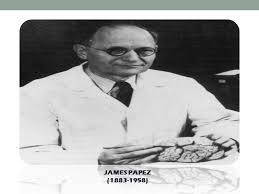What Is The Circuit Of Papez

The Papez circuit is one of the most fundamental neural circuits of the limbic system. It is responsible for managing the emotional expressions and the closed neural circuitry that begins and finishes in the hippocampus. According to James Papez, who discovered the circuit and its significance, the Papez circuit is the basis of emotional experiences and their cortical control. It plays a major role in memory storage of the human brain.
The Papez Circuit
Papez Works
Papez was quite clearly the pioneer of comparative neuroanatomy and one of the world’s best analyzers of brain anatomy in the twentieth-century. In an effort to explore the origins of emotion in the human brain, he explained the presence and working of a neural network that later came to be known as the Papez circuit. His explanation was confined to the limitations of that age and due to lack of proper technology, many of his proposals were based on lose speculations. Nevertheless, it soon became known as the earliest examples of explaining complex neural or mental connections in the human brain at a systems or network-level. Amazingly, most of the brain wiring schemes proposed by Papez despite technological restrictions, turned out to be quite accurate with modern techniques. Although modern techniques also revealed that his description of the Papez circuitry as the center for human emotions was largely incorrect, neuroscientists still hail this as an important discovery of great experimental value. It led to numerous other research projects and all of them started off by building upon the circuit theory brought forward by Papez.
James Papez Career
Born in 1883, James Wenceslas Papez belonged to a small town American family of Czech descent in Glencoe, Minnesota. He completed his undergraduate studies and joined the University of Minnesota’s College of Medicine and Surgery. He was awarded with an MD in 1911 after which he began training in neuroanatomy under the mentorship of a renowned neuroanatomist, John Black Johnston. Johnston published a beautifully illustrated book in 1906 giving Papez a source of inspiration for his works later on in his career.
During the time between 1914 and 1920, Papez served at University of Atlanta as a member of faculty. In 1920, he started working as an assistant professor in the Ithaca Division of Cornell University’s Medical College. Cornell zoology professor and founder of a famous brain collection, Burt Wilder, played an instrumental role in making sure that Papez gets a position at Cornell.
His time at Cornell proved to be the most productive years of his professional life where he conducted research on the human brain anatomy resulting in lots of publications. Along with this, Papez also curated for the Wilder Brain Collection, an organization that preserved human brains for scientific purposes. The organization had a considerable collection of human brains including donations from famous people, especially one from the founder of the organization himself.
During his time at Cornell, Papez covered subjects ranging from anatomy to human development and anthropology. His 1937 description of the Papez circuit earned him a prominent, famous name among the world’s top neuroscientists.







